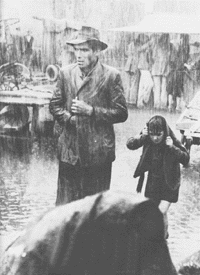Scanlines
The Bicycle Thief
Fri., July 25, 1997
With L'Amberto Maggiorani, Enzo Staiola, Lionella Carell.
|
|
The Sadist
D: James Landis (1963)
with Arch Hall Jr., Helen Hovey, Richard Alden, Marilyn Manning, Don Russell.
Okay, maybe you've seen Arch Hall, Jr. coast breezily through movies like Eegah! or Wild Guitar utterly unfettered by talent, but that won't prepare you for this. Three teachers (two male, one female and sexy) in an Impala have car trouble and stop in a garage/junkyard where they are accosted by leering, giggling thug Arch Hall, Jr. and his Appalachian-trash girlfriend. Soon, he pistol-whips the middle-aged teacher, then gives him the time it takes to chugalug a grape Nehi to whimper, grovel, and beg for his life before blasting him with a .45. He then makes things miserable for the other two while the guy grapples with the fuel pump on the Chevy, and smokes two motorcycle cops who stumble onto the place. Hall (in construction boots, high-water Levi's and denim jacket) is half-creepy, half-simpleton as the killer on the run; along with his girlfriend, they conjure up homicidal hick geek losers Charlie Starkweather and Caryl Fugate. The Sadist is frustrating, though, for all the times when the teacher could have jumped Hall but didn't because he was too much of a yellabelly. Finally he calls up enough cojones to give Hall a faceful of gasoline from a gas pump, but instead of doing something decisive like paste him with the pump nozzle or slam the damn car hood on his head, he just runs off like a fourth grader! And he looks like he should be able to mop up the floor with Hall! A genuinely tense, nerve-racking trash thriller (with great camera work by Vilmos -- billed as "William" -- Zsigmond), heightened by Arch's moronic sneer and the unbelievable structure of his blond pompadour. -- Jerry Renshaw
Classical Hollywood cin- ema granted its viewers resolute plotlines which rarely told the whole story. That, of course, created the charm many contemporary audiences and critics bemoan the absence of as they wistfully ponder a Now, Voyager or a Swing Time. But what about darker, more politically oriented classical Hollywood movies that passed themselves off as melodramas, or noirs, or Westerns --anything but what their displaced subject matter subtly articulated? Case in point is 1952's Western Rancho Notorious (D: Fritz Lang; with Marlene Dietrich, Arthur Kennedy, Mel Ferrer), which for a first-time, contemporary viewer should do far more than raise eyebrows. Here's a flick about a mysterious ranch hideout known only to those few in the know as Chuck-a-luck, in which Marlene Dietrich plays Altar Keane, a former good-time girl of the Wild West who runs a ring of bandits given sanctuary at the ranch as long as they give Dietrich the obligatory 10 percent cut. Kennedy plays an innocent but hell-bent-on-revenge protagonist whose fiancée is brutally murdered by two of the bandits. Kennedy finds his way to Chuck-a-luck, but only by his own wile -- the principal deterrent to his arriving there being the fact that no one will provide him the needed information about how to get there, and those who do seem to know about Chuck-a-luck's location turn a very blind eye to its denizens' murderous tendencies. Sound anything like political events in WWII Germany? After all, Rancho is made by a refugee of the Holocaust, and stars Germany's best-known cinematic cultural export. But to watch it as just another Western really does no harm; the producers intended it as a Western, by god, and it sure as hell is one, even if you don't look for the telltale signs that much more is going on here than Hollywood's ticket-takers would like for you to know. But for perhaps an even more deeply allegorical Lang film, check out The Big Heat (1953; with Glenn Ford, Gloria Grahame, Jocelyn Brando, Lee Marvin, Carolyn Jones) which, at least on the surface, is about city detective Tom Banyon's attempt to end the corrupting control of a mafia-like "syndicate" which has its hands in every corner of city government. But when Banyon's wife is killed by accident -- the car bomb intended for Banyon instead strikes his wife -- The Big Heat really becomes an account of what happens to Banyon in his pursuit of vengeance. The attack on Banyon's wife, in which the bomb explosion is visualized with a white flash similar to the kind created for Fifties cautionary Cold War documentaries about atomic explosions, is only the beginning of the film's several atomic references, the most affecting of which are the facial scars left on a gangster and his moll (Grahame) after this film's particular atomic liquid, coffee, is poured on both their faces, each by the other, no less! The scars mimic radiation burns left on Hiroshima victims in WWII bombing. But once again, this film can be watched without knowledge of the atomic allegory that sneaks throughout the film -- it's just a far more fascinating experience watching these films on more than one level, as the widened scopes they were intended to be. -- Claiborne K.H.Smith







